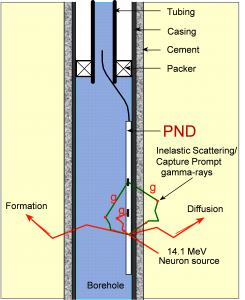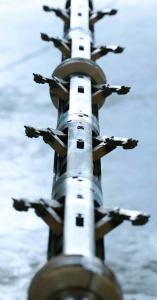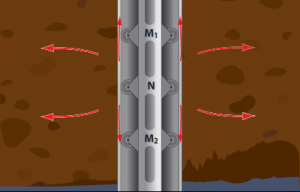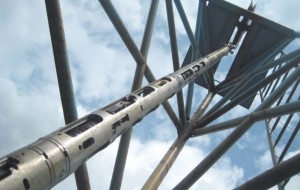

After well completion and once the production of a well has started, the reservoir has to be constantly monitored to understand its behavior and extend its life and make the production an efficient process. Rates of production on surface (oil, gas & water) are a good indication but sometimes downhole measurements are needed as movement of fluids in the reservoir and between wells
The PND instrument contains an advanced neutron generator design and fast efficient Gamma Ray detectors which help to make the PND an efficient tool for reservoir saturation and capable of detailed formation evaluation through casing and more complex completions.
Lithology determination, reservoir saturation and Sigma measurements are some of the comprehensive details provided by this mode.
It provides borehole formation cross-section in addition to the ratio porosity, for both liquid-filled and gas-filled boreholes. The reservoir monitoring tool separates the borehole and the formation components of the decay in order to improve estimate of sigma formation.
When used in C/O logging mode, the abundance of carbon and oxygen in the reservoir is measured and the response is mapped to oil saturation. This measurement is very borehole sensitive, resulting in a clear understanding of the wellbore construction and fluids as well as cement quality verification. This is typically used in downhole conditions where the formation water salinity is low (fresh water) and Sigma measurements are deemed inconclusive.
Low porosity zones as a result of low response range, identify high oil saturation uncertainty. Depending on the reservoir conditions and analysis, the C/O log typically consists of 3 logging passes at 6 ft. per minute.



Resistivity Behind Casing Tool– RBC measures deep true formation resistivity behind steel casing to detect and evaluate bypassed hydrocarbons. Saturations determined from resistivity measurements are considered better than the data acquired by pulsed neutron logging tools due to the fact that the depth of investigation is significantly higher than standard nuclear measurements. The depth of investigation is from 7 to 32 ft, depending on well conditions.
The RBC is a stationary tool. The electrical current output from the probes moves from above and below in the steel casing in turn in time through current electrodes. The majority of the current travels through the casing column while the remaining “leaked current†enters the formation. The leaked current is measured and processed to determine the formation resistivity with the casing column influence removed.


